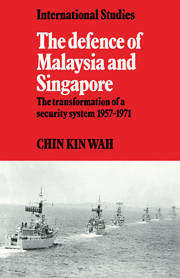Book contents
- Frontmatter
- Contents
- Preface
- Acknowledgements
- List of abbreviations
- Note on currency units
- 1 Introduction
- 2 Pre-treaty defence relations
- 3 Decolonisation and the institution of the defence agreement
- 4 The extension of AMDA
- 5 The external testing of AMDA
- 6 Towards a closing of ranks
- 7 The fractured axis
- 8 Britain weighs anchor
- 9 From AMDA to the five-power defence system
- 10 Conclusions
- Postscript on five-power arrangements
- Notes
- Bibliography
- Index
9 - From AMDA to the five-power defence system
Published online by Cambridge University Press: 07 October 2011
- Frontmatter
- Contents
- Preface
- Acknowledgements
- List of abbreviations
- Note on currency units
- 1 Introduction
- 2 Pre-treaty defence relations
- 3 Decolonisation and the institution of the defence agreement
- 4 The extension of AMDA
- 5 The external testing of AMDA
- 6 Towards a closing of ranks
- 7 The fractured axis
- 8 Britain weighs anchor
- 9 From AMDA to the five-power defence system
- 10 Conclusions
- Postscript on five-power arrangements
- Notes
- Bibliography
- Index
Summary
The Tunku's proposal for a five-power conference, first made in July 1967, received increasing support once it was clear that Britain was no longer prepared to play the role of anchor power to AMDA. But the main obstacle to a revision of AMDA was the defence relationship between Malaysia and Singapore, whose interests, though close, were nevertheless differentiate. On account of their history of past difficulties in defence co-operation, the external allies were inclined to let them work out a basis for future collaboration.
The most immediate defence need of Singapore (following British withdrawal) was a close functional co-operation with Malaysia. Their geographical propinquity and the size of Singapore island meant that an effective air defence system for Singapore could not be provided without reference to the Malaysian hinterland. The short reaction time available to meet encroaching hostile aircraft meant that a continuing close identification of Malaysia–Singapore interests would have to be established, at least in matters of air defence. Moreover, maintaining separate defence systems with sophisticated weapons would be too expensive.
There were, nevertheless, certain differences in Malaysia–Singapore attitudes towards air defence. As was pointed out to Vishal Singh by a senior Malaysian official, Malaysia was less concerned with air defence per se, but instead desired a more collective air defence involvement among all the partners. But in those aspects of air defence which exclusively concerned Malaysia–Singapore (e.g. fixed installations), Malaysia would prefer joint ownership and administration.
- Type
- Chapter
- Information
- The Defence of Malaysia and SingaporeThe Transformation of a Security System 1957–1971, pp. 144 - 178Publisher: Cambridge University PressPrint publication year: 1982



